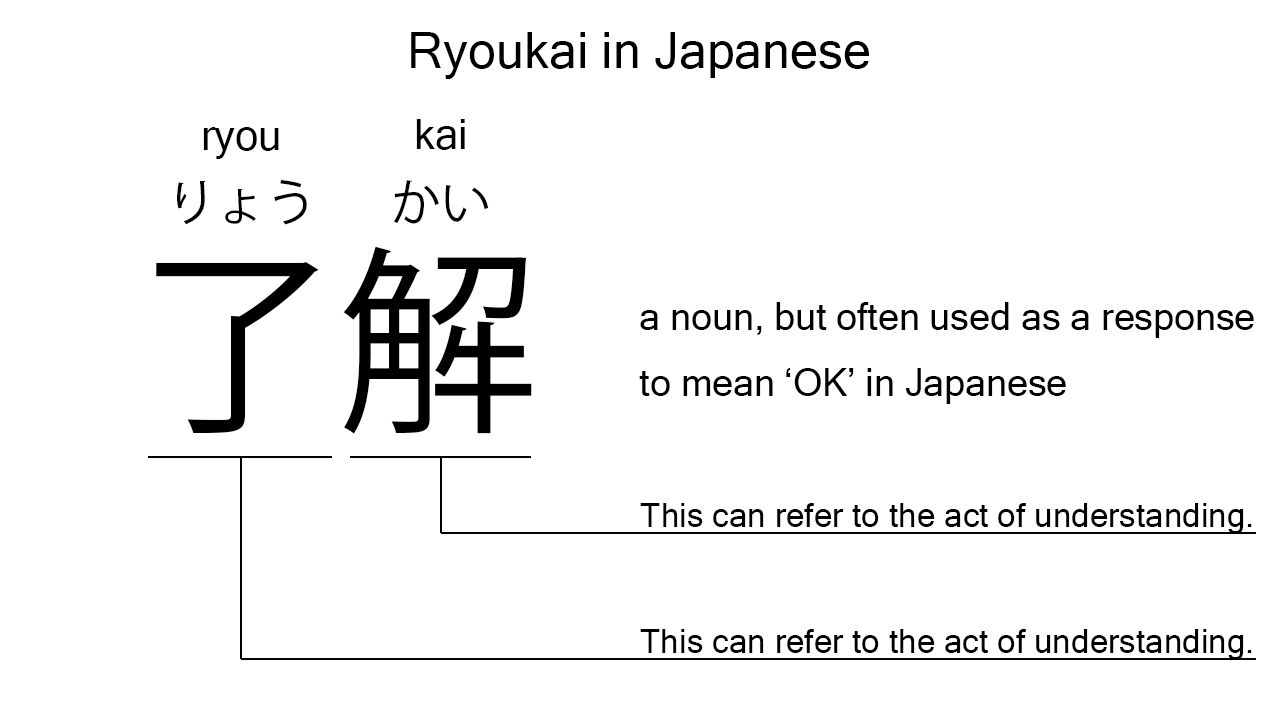What does “ryoukai” mean in Japanese?
Native speakers say “ryoukai” often to mean ‘OK’ in Japanese. Perhaps, some Japanese learners know this word as it is sometimes used in Japanese conversations. In this blog post, however, I will explain it in detail based on its kanji expression. And also, I will explain how to use it through example sentences. My explanations would help Japanese learners understand “ryoukai” more clearly. Then, let’s get started!
Contents
Definition and meanings of “ryoukai”
Let me start with the definition and meanings of “ryoukai”.
- ryoukai – 了解 (りょうかい) : a noun meaning ‘understanding’ or ‘comprehension’ in Japanese.
Grammatically this is a noun. However, Japanese native speakers use this quite often as a response to say “OK”, “roger”, “I got it”, or such. Japanese learners should focus on this usage first.
The definition and meanings are not that difficult, I think. To understand this word more clearly, however, let me explain its kanji characters in detail, one by one.
What does “ryoukai” literally mean in Japanese?
The kanji expression of “ryoukai” consists of the following two kanji characters:
- 了 : the simplified form of “諒” which is used to refer to the act of accepting or understanding.
- 解 : a kanji character widely used to refer to the act of understanding.
These two kanji characters tell us that “ryoukai” literally means ‘understanding’ in Japanese. This literal interpretation is very close to the actual meanings as a noun. Again, but native speakers use “ryoukai” quite often as a response to say “OK”, “roger”, “I got it”, or such in Japanese. So, there is still a slight gap between the literal meaning and the actual.

When we meet new kanji expressions, we should check their kanji characters in detail to understand their meanings clearly and deeply. In many cases, kanji characters tell us a lot about the meanings of the expressions they form. Actually, here, we could get the better understanding of “ryoukai” through the detailed kanji check above.
So far, I’ve explained the definition and meanings of “ryoukai” together with its kanji characters. Then, let me explain how to use it through the example sentences below.
Example #1: how to say “OK” to a request in Japanese
「ashita wa hayaku ki te kudasai」「ryoukai」 – 「明日は早く来てください」「了解」 (「あしたははやくきてください」「りょうかい」)
“Please come earlier tomorrow.” “OK!”
Below are the new words used in the example sentence.
- ashita – 明日 (あした) : a noun meaning ‘tomorrow’ in Japanese.
- wa – は : a binding particle working as a case marker or topic marker. In the example, this works as a topic marker after “ashita” to put a focus on it.
- hayaku – 早く (はやく) : one conjugation of the i-adjective, “hayai“, which means ‘early’ in Japanese. In the example, it has been conjugated for the better connection with its following word.
- ki – 来 (き) : one conjugation of the verb, “kuru“, which means ‘to come’ in Japanese. In the example, it has been conjugated for the better connection with its following word.
- te – て : a conjunctive particle used after a verb, adjective, or auxiliary verb to make its te form. In the example, this is used after “ki” to make its te form, “ki te”. Verbs need to be changed to their te forms to be connected with “kudasai”.
- kudasai – ください : one conjugation of the verb, “kudasaru”, which means ‘to give’ or such in Japanese. When this follows a verb, however, this can work like an auxiliary verb to add the meaning of ‘please’. In the example, this works after “ki te” to add the meaning of ‘please’.
This is a typical usage of “ryoukai”. In this example, it works as a response to say “OK” to what someone has just said. When we want to say “OK”, “roger”, “I got it”, or such to a request or suggestion, this word is a very good option.
Example #2: another usage of “ryoukai”
「kyou wa hayaku kaet te kudasai」「ryoukai desu」 – 「今日は早く帰ってください」「了解です」 (「きょうははやくかえってください」「りょうかいです」)
“Please go home early today.” “Understood!”
Below are the new words used in the example sentence.
- kyou – 今日 (きょう) : a noun meaning ‘today’ in Japanese.
- kaet – 帰っ (かえっ) : one conjugation of the verb, “kaeru”, which means ‘to go home’ or such in Japanese. In the example, it has been conjugated for the better connection with its following word.
- desu – です : an auxiliary verb used after a noun or adjective to make it polite. Probably, this is well known as a part of Japanese desu form. In the example, this is used after “ryoukai” to make it sound polite.
This is another typical usage of “ryoukai”. Like in this example, it can work well together with “desu” to become a more polite response. It’s worth knowing, I think.
Summary
In this blog post, I’ve explained the definition and meanings of “ryoukai” in detail based on its kanji expression. And also, I’ve explained how to use it through the example sentences. Let me summarize them as follows.
- ryoukai – 了解 (りょうかい) : a noun meaning ‘understanding’ or ‘comprehension’ in Japanese. Grammatically this is a noun. However, Japanese native speakers use this quite often as a response to say “OK”, “roger”, “I got it”, or such. Japanese learners should focus on this usage first.
Hope my explanations are understandable and helpful for Japanese learners.